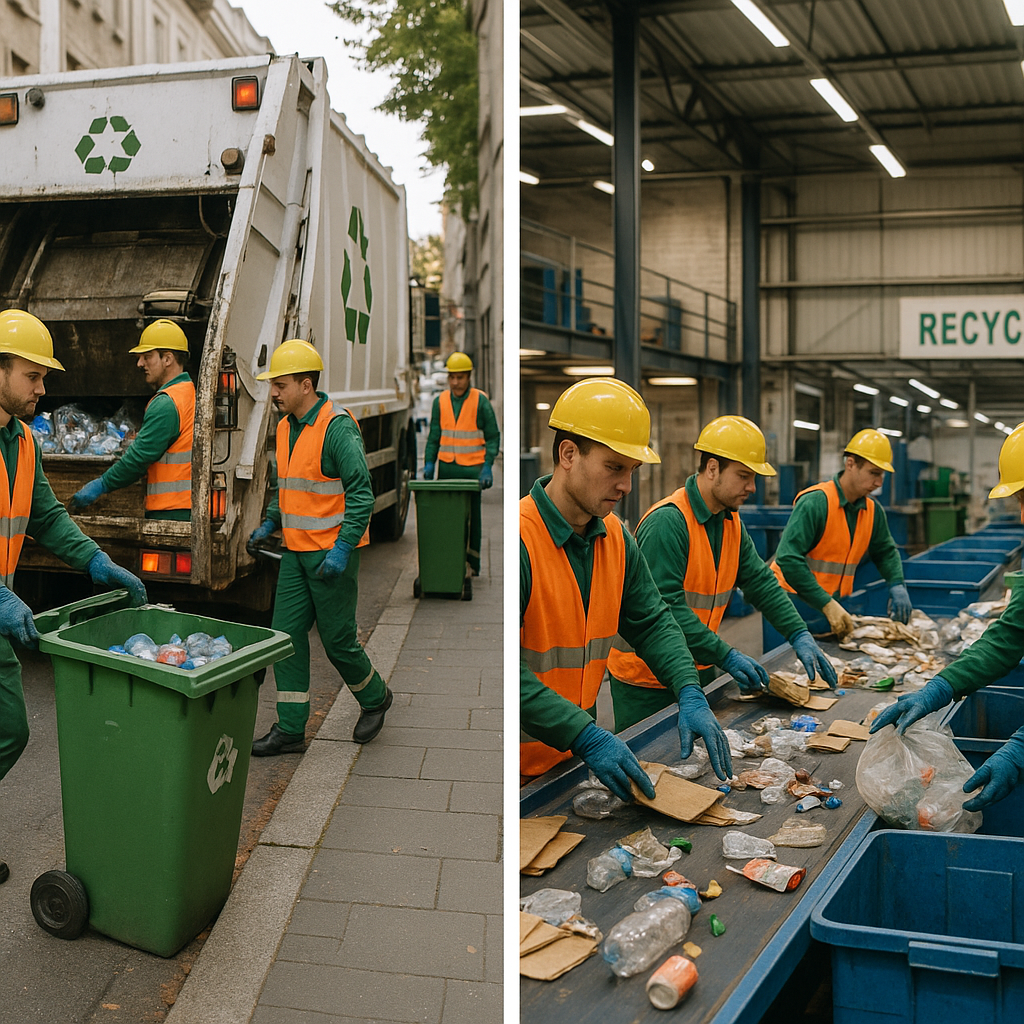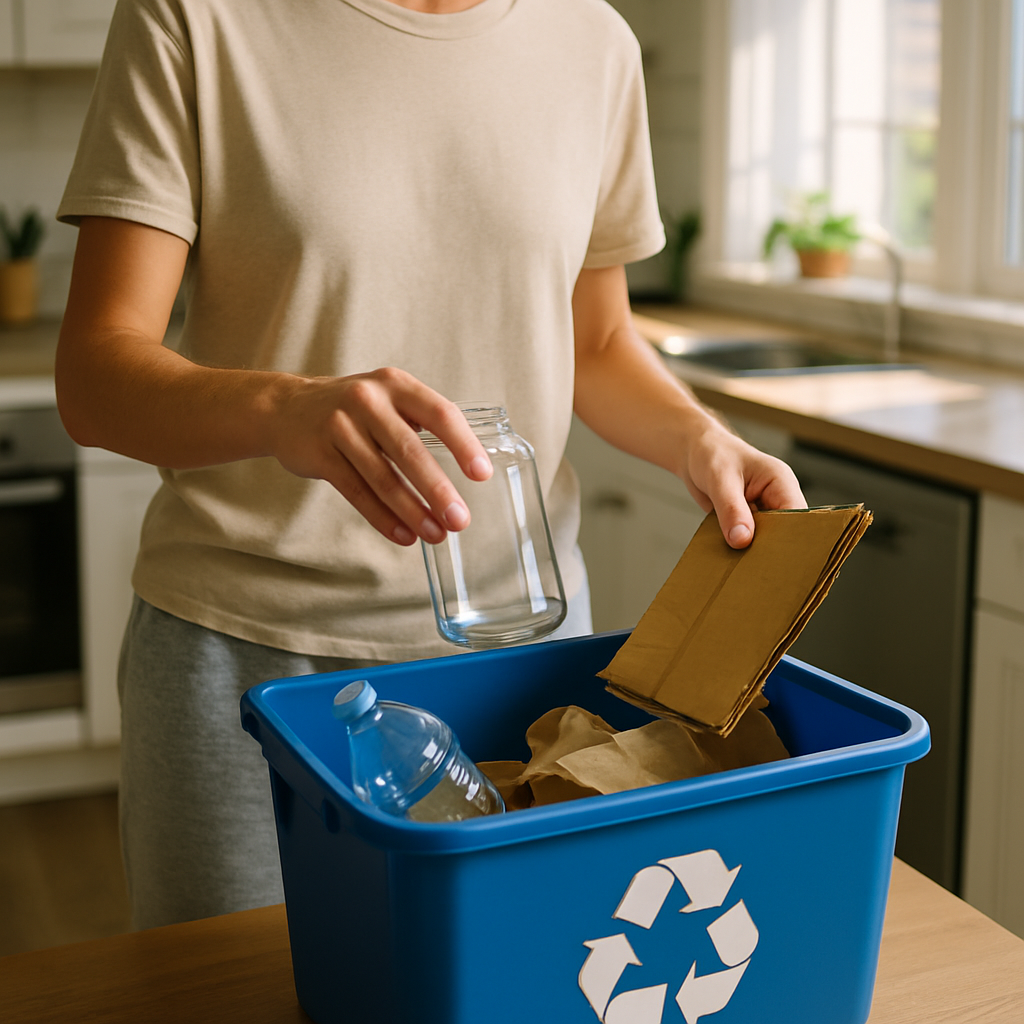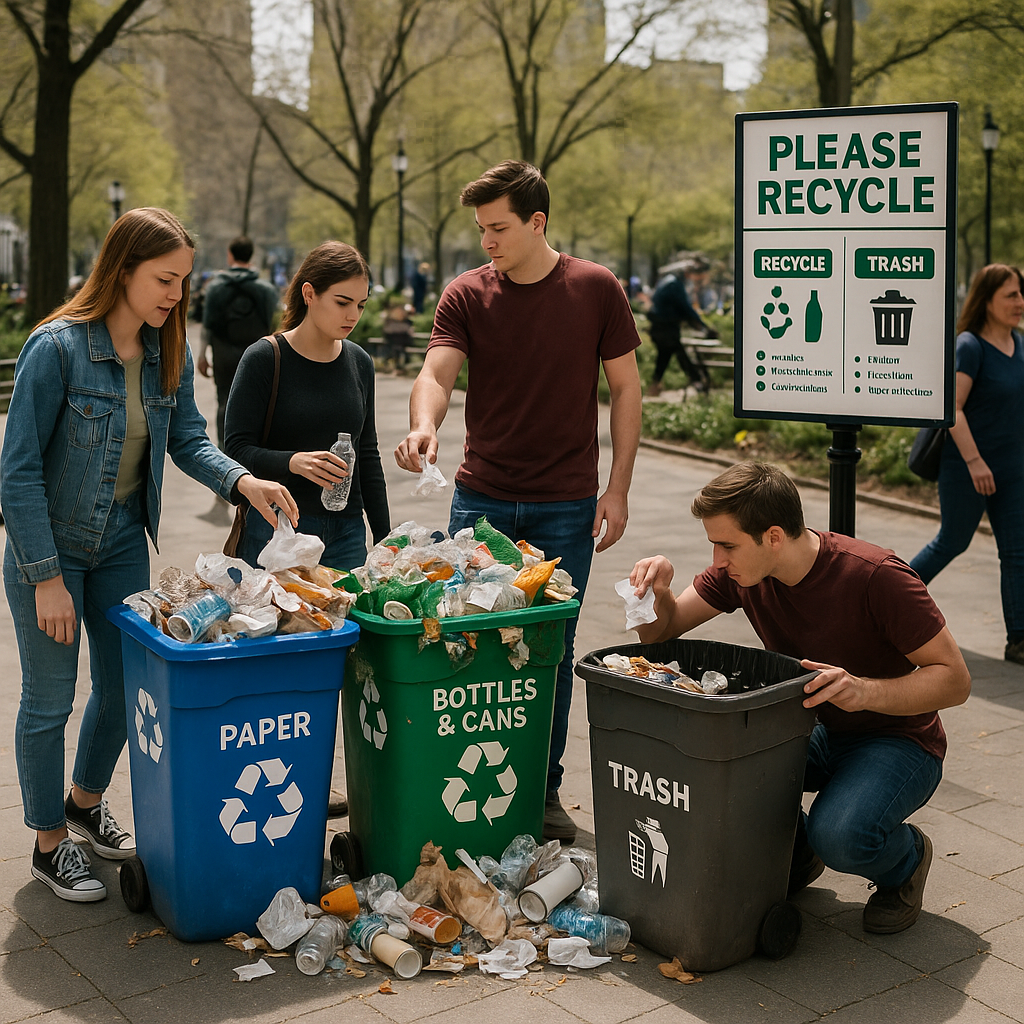5901 Botham Jean Blvd, Dallas, TX 75215
Discover the Essential Steps in the Public Recycling Process
August 16, 2025Every time you toss a plastic bottle or cardboard box into a recycling bin, you’re starting a journey that rejuvenates materials that would otherwise end up in landfills. The public recycling process consists of three main steps: collection and processing, manufacturing, and purchasing recycled products. This loop keeps resources in circulation and reduces the need for virgin materials.
The collection and processing phase begins at your curb or community recycling center. Items are gathered, sorted, and prepared for transformation. Manufacturers then take these processed materials and convert them into new products for store shelves. The final step occurs when consumers and businesses purchase these recycled-content products, completing the cycle and driving demand for more recycled materials.
The familiar recycling symbol of chasing arrows on products worldwide represents this three-step process. Each arrow signifies a crucial link in the chain that makes recycling economically viable and environmentally beneficial. If any step falters—due to contamination during collection, manufacturing challenges, or weak market demand—the system becomes less effective.
Understanding these interconnected phases helps us see how our actions contribute to a sustainable waste management system.
How Does Collection and Processing Work?

Recycling begins with collection, the crucial first step in diverting materials from landfills. Collection services gather recyclables from homes, schools, businesses, and public spaces through various methods. Curbside pickup programs allow residents to place designated recycling bins at the curb for regular collection. Community drop-off centers offer convenient locations for recyclables, particularly in areas without curbside service.
Once collected, these materials are transported to a Materials Recovery Facility (MRF), where the transformation begins. At the MRF, trucks unload materials onto a tipping floor where they’re weighed and inspected. Workers remove obvious contaminants before a mechanical shovel feeds materials onto conveyor belts for sorting.
The sorting process combines sophisticated technology with manual labor. Rotating screens separate materials by size, allowing smaller items to fall through while larger ones continue down the line. Air classifiers use streams of air to separate lightweight materials like paper from heavier items like glass and metal. Powerful magnets extract ferrous metals from the stream, while eddy current separators divert non-ferrous metals like aluminum.
For plastics, optical sorters using near-infrared technology identify different resin types. These advanced systems can process materials at impressive speeds, making thousands of sorting decisions per minute. Throughout this process, quality control staff monitor the lines, removing contaminants that machines miss.
After sorting, materials undergo cleaning to remove labels, adhesives, and residual contents. The materials are then compressed into dense bales or, in the case of glass, crushed for easier transportation. These processed materials become valuable commodities in the recycling market, with prices fluctuating based on supply and demand factors.
The efficiency of MRFs varies significantly based on equipment sophistication and contamination levels. Modern facilities with advanced technology can sort materials with remarkable precision, but they still face challenges from improper recycling practices. When non-recyclable items enter the stream, they can damage equipment, contaminate good materials, and force facilities to send otherwise recyclable items to landfills.
According to EPA data, the U.S. currently recycles about 32% of municipal solid waste, a significant improvement from just 7% in 1960. However, certain materials like paper and cardboard enjoy much higher recycling rates than plastics, which remain challenging to recover and process efficiently.
Collection and processing costs represent significant expenses for recycling programs. The economics of recycling depend heavily on clean, well-sorted materials reaching the proper recovery streams. MRFs must pay “tipping fees” to dispose of contaminated materials they can’t process, making proper recycling education essential for program sustainability.
| Materials | Processing at MRF |
| Ferrous Metals | Separated using electromagnets |
| Non-Ferrous Metals (e.g., aluminum) | Separated using eddy current separators |
| Plastics (#1, #2, #5) | Separated by polymer type using infrared technology |
| Paper/Cardboard | Separated by type and then compacted for shipment |
| Glass | Crushed into cullet for ease of transportation |
| Mixed Paper | Includes items like newspapers, office paper, and junk mail |
How Do Consumers Complete the Recycling Loop?

Consumers play a crucial role in closing the recycling loop. While sorting and disposing of recyclable materials properly is vital, the cycle remains incomplete without purchasing products made from recycled materials. This consumer-driven demand encourages manufacturers to incorporate more recycled content in their products.
The recycling loop works effectively when consumers make informed choices at the store. Studies show that most shoppers consider the recyclability of products important. Research from Stena Recycling indicates that approximately 76% of consumers believe it’s important for manufacturers to use recycled materials in their products.
When shopping, look for clear labels and symbols that indicate recycled content. These markers help identify products that contribute to resource conservation and waste reduction.
Understanding Recycled Content Labels
Product packaging often features various recycling symbols and claims that can help you make environmentally responsible purchasing decisions. Here are key terms to understand:
- Post-consumer recycled content (PCR): Materials reclaimed from products that have already been used by consumers and reached the end of their lifecycle. This represents the most environmentally valuable form of recycled content.
- Pre-consumer (post-industrial) recycled content (PIR): Materials recovered from manufacturing waste that never reached consumers. These materials would otherwise have been discarded.
- Total recycled content: The combined percentage of post-consumer and pre-consumer recycled materials in a product.
- Recyclable: Indicates the product can be recycled after use, though this doesn’t mean it contains recycled content.
Many products display specific percentages of recycled content, such as “made with 30% post-consumer recycled plastic.” Higher percentages generally indicate greater environmental benefits.
Common Products with Recycled Content
Many everyday items now contain significant amounts of recycled materials:
- Paper products: Notebooks, printing paper, paper towels, toilet paper, and packaging often contain high percentages of recycled paper fibers.
- Plastic containers: Look for recycled PET (rPET) in bottles, food containers, and packaging.
- Aluminum products: Beverage cans, cookware, and certain building materials frequently contain recycled aluminum, which saves over 90% of the energy required to produce virgin aluminum.
- Glass items: Many glass containers incorporate recycled glass, which helps reduce energy consumption in manufacturing.
- Carpeting and textiles: Many carpet manufacturers use recycled plastic bottles to create polyester carpet fibers.
- Construction materials: Recycled content can be found in insulation, composite lumber, roofing materials, and concrete.
Research by McKinsey found that consumers across different market segments express interest in products with recycled content. For beverages, consumers prefer plastic bottles that are either fully recyclable or made entirely from recycled content. In household products, there’s strong demand for packaging with higher recycled content.
| Symbol | Unicode | Meaning |
| ♲ | U+2672 | Universal Recycling Symbol |
| ♺ | U+267A | Recycling Symbol for Generic Materials |
| ♻ | U+267B | Black Universal Recycling Symbol |
| ♼ | U+267C | Recycled Paper Symbol (indicates product contains recycled paper) |
| ♽ | U+267D | Partially-Recycled Paper Symbol (indicates product contains partially recycled paper) |
| ♾ | U+267E | Permanent Paper Sign (e.g., for acid-free paper) |
Making Informed Purchasing Decisions
To effectively support the recycling loop as a consumer:
- Check labels carefully: Look beyond vague claims like “eco-friendly” and seek specific information about recycled content percentages.
- Support transparent companies: Choose brands that clearly communicate their recycled content levels and sustainability practices.
- Consider the full lifecycle: Select products that are both made from recycled materials and can be recycled again after use.
- Look for third-party verification: Certifications from organizations like UL (Underwriters Laboratories) provide independent validation of recycled content claims.
By intentionally purchasing products with recycled content, consumers create market demand that encourages manufacturers to increase their use of recycled materials. This completes the recycling loop and reduces the need for virgin resource extraction, ultimately conserving energy and reducing waste sent to landfills.
What are the Benefits and Challenges of Public Recycling?
Environmental Benefits of Recycling
Recycling is a key component of environmental sustainability. It conserves natural resources by reducing the need for virgin materials. For example, each ton of recycled paper saves approximately 17 trees, protecting woodland ecosystems from deforestation.
Recycling also significantly reduces pollution. Manufacturing using recycled materials typically emits fewer pollutants than using raw materials. For example, aluminum recycling uses only about 5% of the energy required to produce aluminum from bauxite ore, leading to lower greenhouse gas emissions.
Reducing landfill waste is another vital benefit. According to EPA data, recycling and composting prevented over 190 million metric tons of carbon dioxide equivalent from entering the atmosphere in 2018. This reduction helps minimize methane emissions from landfills, a greenhouse gas 25 times more potent than carbon dioxide.
Economic Advantages of Recycling Programs
Recycling also has significant economic impacts. The industry supports over 1.1 million jobs nationwide, covering sectors like collection, sorting, processing, and manufacturing, and offering diverse job opportunities at various skill levels.
Recycling creates significantly more jobs than traditional waste disposal. Processing 10,000 tons of waste through recycling generates 36 jobs, compared to just one through incineration. This generates around $236 billion in gross annual sales and $37 billion in payroll annually.
Recycling can also reduce municipal waste management costs. Recycling materials instead of landfilling reduces expenses related to waste transportation, disposal, and landfill maintenance, allowing resources to be redirected to other essential services.
Community and Social Benefits
Recycling programs build community cohesion through collective efforts. Participation in local recycling fosters a shared commitment, strengthening bonds between residents who might not otherwise interact.
Such programs also offer educational opportunities. Workshops on proper recycling practices promote learning and discussion about broader environmental issues, fostering community dialogue.
Successful programs change how people interact with their environment. Observing others engage in sustainable practices, like recycling, normalizes these actions and strengthens community environmental stewardship values.
Challenges in Public Recycling Programs
Consumer confusion is a significant challenge, as many people are unsure which materials are recyclable. This confusion leads to contamination when non-recyclable items are placed in recycling bins. A 2021 Paper and Packaging Board survey found fewer than half of Americans who recycle know the basics.
Infrastructure limitations also hinder many communities. Inadequate collection systems, outdated sorting facilities, and insufficient processing capacity restrict recycling capabilities. Many areas lack the equipment and technology to handle growing volumes of recyclables effectively.
Economic factors further complicate these efforts. Fluctuations in recycled material prices create uncertainty for programs. When commodity prices drop, sustaining recycling operations becomes more challenging, highlighting the need for stronger domestic markets.
Addressing Recycling Program Challenges
Education and awareness campaigns improve recycling outcomes. Clear, consistent messaging about recyclable materials reduces contamination, and communities investing in public education see higher participation and cleaner recycling streams.
Infrastructure investment is necessary for effective recycling. Updating collection equipment, modernizing sorting facilities, and expanding processing capacity enable more efficient handling of increased material volumes. The EPA’s Solid Waste Infrastructure for Recycling Grants provides funding for such improvements.
Supportive policies at local, state, and federal levels can enhance recycling programs. Initiatives like extended producer responsibility, recycling mandates, and financial incentives foster participation and create more stable markets for recycled materials, addressing economic challenges.
Technological innovation expands recycling possibilities. Advanced sorting equipment, artificial intelligence applications, and new processing methods improve efficiency and effectiveness, helping recover more materials and produce higher-quality recycled content.
Conclusion: The Future of Public Recycling

Public recycling is advancing as technology improves and awareness increases. The EPA’s National Recycling Strategy is a considerable effort to reform our current system by tackling issues like contamination, outdated infrastructure, and inconsistent measurement standards. Aiming to boost the U.S. recycling rate to 50% by 2030, the strategy outlines a roadmap for a more resilient and effective national recycling system.
Moving forward requires cooperation among government agencies, businesses, and individuals. Although the challenges are significant, solutions are attainable. By reducing contamination through improved education, investing in modern processing infrastructure, and creating stronger markets for recycled materials, we can build a sustainable recycling ecosystem that conserves natural resources and minimizes environmental impact.
For inquiries about waste management solutions or to enhance your organization’s recycling program, contact Okon Recycling at 214-717-4083.
